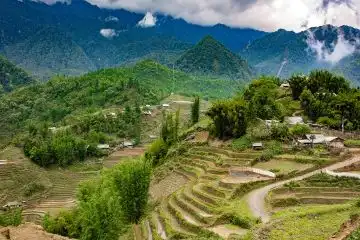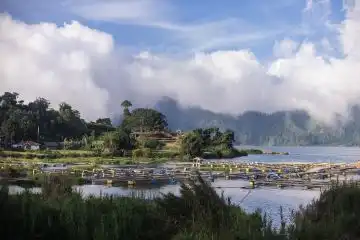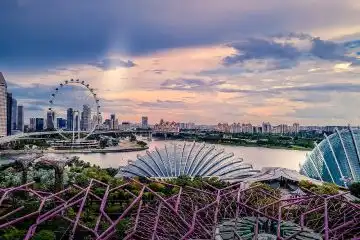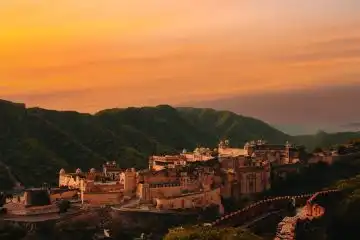Experience the majestic mountains and villages of Sapa Vietnam
Tucked high in the Hoàng Liên Son Mountains of northwestern Vietnam, Sapa is a beautiful land. This immersive experience is centered around the timeless villages of Sapa Vietnam and the majestic mountains. There, history, nature, and tradition beautifully intersect with each other. In Sapa mist floats over emerald terraces and time slows down with the rhythm of village life. Famous for its cooler climate, striking landscapes, and deep-rooted cultural heritage, Sapa offers a multifaceted experience. That further blends adventure, authenticity, and serenity. It's not only a place you visit-but also one you can feel. A trip here means waking up to birdsong in a wooden stilt house and wandering misty paths. That wind through rice paddies, and greeting locals dressed in vibrant traditional attire.
The Endless Beauty of the Rice Terraces
One of the most captivating visuals in Sapa is the rolling sea of rice terraces. That sprawl across its valleys and mountain slopes. Carefully carved by generations of local farmers, these terraced fields are not only agricultural marvels but also stunning works of living art. As the seasons shift, so do the colors of the landscape. Explore the top wonders of hospitality also while touring the villages. They turn from the bright greens of planting season to the golden hues of harvest time. Travelers often find themselves mesmerized by the symmetry and serenity of these fields, especially in Muong Hoa Valley. That is one of the most picturesque regions in the area. Tourists can view them from a hilltop or while hiking through narrow trails. These terraces further provide a tranquil and humbling connection to nature.
Exploring the Heart and Soul of Sapa: Its Villages
The true essence of Sapa lies beyond the town, in the scattered villages of Sapa. Each of the villages of Sapa Vietnam represents a unique cultural identity. That's tied closely to one of it's ethnic minority groups. Places for example Cat Cat, Ta Van, and Lao Chai are home to Black Hmong and Giay communities. There, traditional dress, farming practices, and language remain deeply ingrained. Visitors making the effort to walk or trek into these villages are rewarded not just with scenic beauty. Thy further offer an intimate look into daily life. Watch children walking to school along muddy paths, women weaving textiles by hand, and elders sharing stories in front of their wooden homes. However, spending time in these villages reveals a side of Vietnam few tourists see. That is meanwhile sincere, spiritual, and quietly powerful.
Fansipan: The Crown of Indochina
At 3147 meters, Mount Fansipan stands as the highest peak in Vietnam and the entire Indochinese Peninsula. Known as the “Roof of Indochina”, this mountain is both a geographical landmark and a spiritual symbol. Adventurous travelers can embark further on multi-day treks through lush jungles and mountain paths to reach the summit. For those seeking a more accessible journey, the Fansipan Legend Cable Car is perfect. It firstly offers a scenic ride to the top in under 20 minutes. Once at the summit, the air is crisp, views are boundless, and a sense of accomplishment is almost tangible. Temples, statues, and flags fluttering in the wind add a sacred touch to the experience. Whether hiked or glided, reaching Fansipan is meanwhile a highlight of any Sapa trip.
Homestays: A Cultural Window into Village Life
For a truly immersive experience, spending a night in a local homestay is a must. These stays offer more than just shelter. They provide an authentic connection with the people and traditions of the villages of Sapa Vietnam. Typically family-run, homestays welcome guests with warm smiles, hearty meals, and stories by the fire. You'll sleep under a thatched roof and wake up to the sounds of roosters and flowing streams. Further, you can eat meals made from fresh, local ingredients. Many homestay hosts are eager to share their customs, from cooking techniques to textile crafts. That allow visitors to step further into a different rhythm of life. It's an enriching exchange where both hosts and guests walk away with deeper understanding and appreciation.
Meet the Ethnic Communities of Sapa
Sapa is a mosaic of cultures and home to more than five ethnic minority groups. That firstly include the Black Hmong, Red Dao, Tay, Giay, and Xa Pho. Each group further maintains distinct languages, traditional dress, spiritual practices, and folklore. Walking through the villages of Sapa Vietnam you'll notice the elegant embroidery of Hmong garments. Watch the bold red headscarves of the Red Dao, and the reserved beauty of Giay festivals. Market days are particularly vibrant, offering opportunities to see different groups interact, trade, and socialize. Engaging with these communities-whether by hiring a local guide or participating in a village festival-opens a deeper understanding of how cultural identity endures in the highlands of Vietnam.
Chasing Waterfalls and Scenic Wonders
Nature's abundance in Sapa extends beyond rice fields and mountains to include its serene waterfalls. Silver Waterfall, located about 12 kilometers from Sapa town, cascades dramatically down the mountain. Above all, it is easily accessible for a quick visit. Further afield is Love Waterfall, reached by a scenic walk through bamboo forests. It is known for its romantic legend involving a fairy and a young woodcutter. These waterfalls offer refreshing respites and are surrounded by idyllic picnic spots. Visiting them adds a refreshing and meditative break from the high-energy treks. That meanwhile give travelers time to soak in the mountain air and natural splendor.
Heaven's Gate and the Tram Ton Pass
Just west of Sapa lies Tram Ton Pass, Vietnam's highest mountain pass. It also houses the famous Heaven's Gate viewpoint. This pass is at over 1900 meters above sea level. It firstly offers one of the most dramatic panoramic views in the country. From this lofty perch, clouds drift below your feet, and the peaks of the Hoàng Liên Son range stretch out into the horizon. It's an excellent spot for sunrise and sunset photography, and a favorite stop for bikers and backpackers alike. A small roadside café allows you to enjoy a cup of Vietnamese coffee. Meanwhile, you can soak in the natural grandeur that only the mountains can provide.
Sapa Town: Where Modern Comfort Meets Mountain Charm
While the surrounding villages offer rustic charm, Sapa town serves as a lively base for travelers. Here, French colonial architecture mingles with traditional markets and contemporary comforts. The Stone Church, built in the early 20th century, stands as an enduring symbol of Sapa's colonial history. Above all, it is still an active place of worship. In the central square, weekend evenings often feature local music and dance performances, creating a festive atmosphere. The town also has a growing culinary scene. That stands out with restaurants serving everything from traditional Vietnamese dishes to Western-style breakfasts. It further makes it a convenient yet authentic stop on your mountain adventure.
Local Cuisine: A Taste of the Highlands
Food in Sapa is a celebration of local flavors. It is heavily influenced by the highland climate and ethnic cooking traditions. Meals often feature wild herbs, forest mushrooms, sticky rice, and grilled meats. One of the more adventurous dishes is “thắng cố”, a traditional Hmong stew made with horse meat and herbs. For more conventional palates, dishes for example roasted pork, corn wine, and grilled trout are perfect. They firstly offer a delicious sampling of Sapa's culinary diversity. Meals in the villages of Sapa Vietnam are typically shared, with communal platters and rice wine toasts. That further make for a warm, festive dining experience. Meanwhile, don't miss the opportunity to try home-cooked meals during your homestay. There, the food is often grown, raised, and cooked right on the premises.
The Markets: Where Culture and Commerce Intersect
Markets are the lifeblood of Sapa's economy and a vibrant part of its cultural expression. Held weekly in town and daily in many villages of Sapa Vietnam, these markets are great places. There, traders, artisans, and farmers from different ethnic groups gather to sell their goods. The colors are dazzling-hand-dyed fabrics, embroidered clothing, bamboo crafts, and silver jewelry create a visual feast. Markets also serve as social spaces where news is exchanged, courtships begin, and communities connect. For travelers, shopping at these markets offers not just souvenirs. They further offer meaningful support for local artisans and a deeper appreciation for their craftsmanship.
Seasonal Festivities and Timeless Traditions
Each season in Sapa brings with it a series of festivals rooted in agricultural cycles and spiritual beliefs. During spring, the Roóng Poọc Festival is held to bless the crops and ensure a prosperous year. In early February, the Hmong celebrate the Gau Tao Festival, featuring traditional games, music, and rituals. These events are wonderful opportunities to see authentic dance, ceremonial dress, and community spirit in action. Try to align your visit to villages of Sapa Vietnam with these celebrations. By that, you gain insight into how tradition continues to guide and unify them, even modern life's encroachment.
Tips for a Rewarding Journey to Sapa
Getting to Sapa typically involves an overnight train or sleeper bus from Hanoi to Lao Cai. After that, you have to take a short drive up the mountain. When packing, remember that Sapa's weather can be unpredictable. It can go through mist, sun, and rain all possible in a single day. However, lightweight layers, sturdy footwear, and rain protection are essential. To make the most of your trip to villages of Sapa Vietnam, consider hiring a local guide from one of the ethnic groups. Many are multilingual and deeply knowledgeable about the area's history and ecology. Most importantly, travel respectfully, be mindful of cultural differences, and approach each interaction with openness.
A Journey That Stays With You
Sapa is not only a destination-but also a transformative experience. Experience the natural beauty, cultural richness, and personal connections. That, you'll firstly make among the villages of Sapa Vietnam have a lasting impact. You can trek through misty rice terraces, share a meal with a local family, or simply breathe in the fresh mountain air. Each moment in Sapa invites you to slow down and connect more deeply-with the land, people, and yourself. For travelers seeking meaning, adventure, and authenticity, Sapa offers all that and more. That too in the embrace of its mountains and hearts of its villages.












